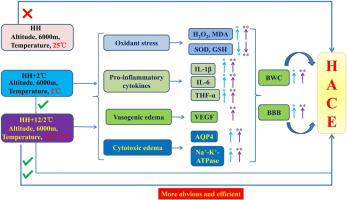Brain Research Bulletin ( IF 3.5 ) Pub Date : 2020-10-24 , DOI: 10.1016/j.brainresbull.2020.10.017 Linlin Jing 1 , Ningzi Wu 1 , Lei He 1 , Jin Shao 1 , Huiping Ma 1

|
High altitude cerebral edema (HACE) is a kind of life threat disease encountered at high altitude, but the precise pathogenesis of it is far more understood. Hypobaic hypoxia (HH) and cold are conditions characteristic of high altitude environment. HH is always considered as the central causative factor for the development of HACE, but the effect of cold stress on HACE has been rarely investigated. The purpose of this study was to investigate the potential role of cold stress in the development of HACE and establish a stable experimental animal model. Male SPF Wistar rats were randomly divided into five groups for this experiment, control group (altitude, 1400 m, temperature, 25 ℃), NC + 2 ℃ group (altitude, 1400 m, temperature, 2 ℃), HH group (altitude, 6000 m, temperature, 25 ℃), HH+2 ℃ group (altitude, 6000 m, temperature, 2 ℃) and HH + 12/2 ℃ (altitude, 6000 m, temperature, 12 ℃/2 ℃ light/dark cycle). After exposure for 72 h, the blood and brain tissues were collected. Brain water content (BWC) and Evans Blue dye extravasation were used to assess the brain edema and blood-brain barrier (BBB) permeability, respectively. The levels of pro-inflammatory cytokines in serum were assessed via enzyme-linked immunosorbent assay. Oxidative stress markers and ATPase activity were determined using commercial kits. Western blotting was used to detect the expression of related proteins. Compared to control, HH+2 ℃ could significantly increase the BWC and BBB permeability, and these changes were further exacerbated by HH + 12/2 ℃. Furthermore, HH+2 ℃ and HH + 12/2 ℃ markedly increased the levels of H2O2 and MDA, restrained SOD and GSH levels and decreased Na+/K+-ATPase activitie compared with the control group. In addition, HH+2 ℃ and HH + 12/2 ℃ enhanced the levels of pro-inflammatory cytokines IL-1β, TNF-α and IL-6 in serum and significantly increased the expression of VEGF in brain compared with the control group, but only HH + 12/2 ℃ could increase the expression of AQP4. However, compared with control group, no significant differences in these parameters were observed in HH and NC+2 ℃groups. These results demonstrated that HH or cold stress alone did not successfully induce brain damage, while HH+2 ℃ could induce the onset of HACE via provoking injury caused by HH. HH + 12/2 ℃ was more obvious and efficient. Collectively, we firstly suggest that cold stress may promote the formation of HACE by aggravating the brain injury induced by HH exposure and supply an effective and reliable experimental rat model of HACE via HH combined with temperature fluctuation.
中文翻译:

低压缺氧结合温度波动大鼠高原脑水肿实验模型的建立
高原脑水肿(HACE)是一种在高海拔地区遇到的威胁生命的疾病,但其确切的发病机制却远为人们所了解。低气压缺氧 (HH) 和寒冷是高海拔环境的特征条件。HH 一直被认为是 HACE 发展的主要致病因素,但很少研究冷应激对 HACE 的影响。本研究旨在探讨冷应激在HACE发生发展中的潜在作用,建立稳定的实验动物模型。本实验将雄性SPF Wistar大鼠随机分为5组,对照组(海拔1400m,温度25℃),NC+2℃组(海拔1400m,温度2℃),HH组(海拔, 6000 m, 温度, 25 ℃), HH+2 ℃组(海拔, 6000 m, 温度, 2 ℃)和 HH + 12/2 ℃(海拔,6000 m,温度,12 ℃/2 ℃ 光/暗循环)。暴露72小时后,收集血液和脑组织。脑含水量 (BWC) 和伊文思蓝染料外渗分别用于评估脑水肿和血脑屏障 (BBB) 通透性。通过酶联免疫吸附测定评估血清中促炎细胞因子的水平。使用商业试剂盒测定氧化应激标记物和 ATPase 活性。Western blotting检测相关蛋白的表达。与对照相比,HH+2 ℃可显着提高BWC和BBB渗透率,而HH+12/2 ℃进一步加剧了这些变化。此外,HH+2 ℃和HH + 12/2 ℃显着增加了H 暴露72小时后,收集血液和脑组织。脑含水量 (BWC) 和伊文思蓝染料外渗分别用于评估脑水肿和血脑屏障 (BBB) 通透性。通过酶联免疫吸附测定评估血清中促炎细胞因子的水平。使用商业试剂盒测定氧化应激标记物和 ATPase 活性。Western blotting检测相关蛋白的表达。与对照相比,HH+2 ℃可显着提高BWC和BBB渗透率,而HH+12/2 ℃进一步加剧了这些变化。此外,HH+2 ℃和HH + 12/2 ℃显着增加了H 暴露72小时后,收集血液和脑组织。脑含水量 (BWC) 和伊文思蓝染料外渗分别用于评估脑水肿和血脑屏障 (BBB) 通透性。通过酶联免疫吸附测定评估血清中促炎细胞因子的水平。使用商业试剂盒测定氧化应激标记物和 ATPase 活性。Western blotting检测相关蛋白的表达。与对照相比,HH+2 ℃可显着提高BWC和BBB渗透率,而HH+12/2 ℃进一步加剧了这些变化。此外,HH+2 ℃和HH + 12/2 ℃显着增加了H 脑含水量 (BWC) 和伊文思蓝染料外渗分别用于评估脑水肿和血脑屏障 (BBB) 通透性。通过酶联免疫吸附测定评估血清中促炎细胞因子的水平。使用商业试剂盒测定氧化应激标记物和 ATPase 活性。Western blotting检测相关蛋白的表达。与对照相比,HH+2 ℃可显着提高BWC和BBB渗透率,而HH+12/2 ℃进一步加剧了这些变化。此外,HH+2 ℃和HH + 12/2 ℃显着增加了H 脑含水量 (BWC) 和伊文思蓝染料外渗分别用于评估脑水肿和血脑屏障 (BBB) 通透性。通过酶联免疫吸附测定评估血清中促炎细胞因子的水平。使用商业试剂盒测定氧化应激标记物和 ATPase 活性。Western blotting检测相关蛋白的表达。与对照相比,HH+2 ℃可显着提高BWC和BBB渗透率,而HH+12/2 ℃进一步加剧了这些变化。此外,HH+2 ℃和HH + 12/2 ℃显着增加了H Western blotting检测相关蛋白的表达。与对照相比,HH+2 ℃可显着提高BWC和BBB渗透率,而HH+12/2 ℃进一步加剧了这些变化。此外,HH+2 ℃和HH + 12/2 ℃显着增加了H Western blotting检测相关蛋白的表达。与对照相比,HH+2 ℃可显着提高BWC和BBB渗透率,而HH+12/2 ℃进一步加剧了这些变化。此外,HH+2 ℃和HH + 12/2 ℃显着增加了H与对照组相比,2 O 2和MDA抑制了SOD和GSH水平并降低了Na + /K + -ATP酶活性。此外,HH+2℃和HH+12/2℃可提高促炎细胞因子IL- 1β、TNF - α的水平与对照组相比,血清中IL-6和脑中VEGF的表达显着增加,但只有HH+12/2℃才能增加AQP4的表达。但与对照组相比,HH组和NC+2℃组这些参数均无显着差异。这些结果表明单独的HH或冷应激不能成功地诱导脑损伤,而HH+2℃可以通过引起HH引起的损伤来诱导HACE的发生。HH+12/2℃效果更明显有效。总的来说,我们首先提出冷应激可能通过加重HH暴露引起的脑损伤来促进HACE的形成,并通过HH结合温度波动提供有效可靠的HACE实验大鼠模型。











































 京公网安备 11010802027423号
京公网安备 11010802027423号